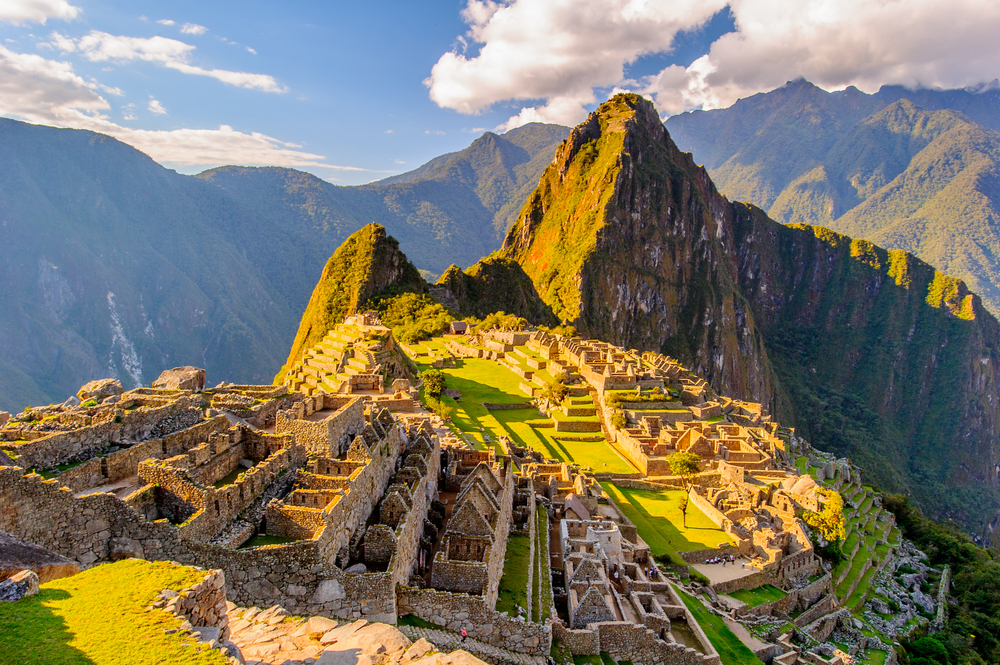
Inca Trail (Machu Picchu) – PeruThe Inca Trail to Machu Picchu is one of the South America ́s and possibly one of the World ́s most famous hikes and journeys and is a bucket list adventure for so many travellers around the world. As the most famous hike in South America, the four-day Inca Trail is walked by thousands of people every year. The ancient trail laid by the Incas winds its way up and down and around the mountains, twisting over three Andean passes which have collectively led to the route being dubbed ‘the Inca Trail.’
On your Peruvian adventure you can follow Inca traditions from Lima to Cusco, journey through the heartland of the Sacred Valley, see the magnificent Ollantaytambo ruins before embarking on the ultimate adventure – trekking to Machu Picchu – all whilst getting closer to the secrets of this civilisation on an absolutely breath-taking adventure.
With an incredible mix of views – from snowy mountain peaks, breath-taking rivers and ranges, and stunning forests flush with orchids, trekking from one cliff-hugging pre-Columbian ruin to the next is simply a magical and unforgettable experience for anyone. Plus, the array of Inca archaeological sites are worthy of a visit of their own!
The Inca Trail to Machu Picchu is in fact a small part of a vast network of trails and roads built by the Incan Empire over 500 years ago. The Inca trails or Qhapaq Ñanare, which means network of trails, are estimated to have covered anywhere between 23,000km and 45,000km in distance and were integral in connecting the Tahuantinsuyo Empire, which ran from Colombia and Ecuador in the North, through Peru, Chile and parts of Argentina, and stretched into Brazil and Bolivia.
Planning your trip? There are few really important things to take note of.
Peru is a year-round destination for travellers, but the dry/winter season – between May and September – is generally the most popular time for trekking. This is when the nights are cooler and there are often wildflowers blooming along the trail.
Regardless of what time of year you decide to hike in Peru, waterproof clothing and hiking boots that are already worn in, thick hiking socks, warm and cool layers of clothing, sunscreen and a fleece are integral. The weather in the Andes can be unpredictable, so you’ll want to ensure you’re well-equipped for your trek.
The rainy season runs from November to March, taking a waterproof clothing at any time of year will come in handy for hikes. The Inca Trail also closes every year in February for maintenance.
With any travel, but especially with this type of trip, travellers must consider the potential safety hazards that come with trekking. Many areas including Cuzco and Machu Picchu, Puno and the Colca Canyon and Lake Titicaca, are above 2,500m. Due to the high altitude the air is thinner and some people can suffer altitude sickness. Altitude sickness can be fatal so it’s important to get the right advice before you travel, know how to reduce your risk, what the symptoms are and what to do if you get them, including medication (Diamox). Also, the sun is unusually strong and it’s easy to get burnt. It’s important to wear sunscreen and other sun protection, and always drink plenty of water.
As this trip involves a lot of walking to see the sites, and if you do the Inca trail, there’ll be a lot of strenuous hiking. The trip is recommended for those with a moderate level of fitness but there are also a few different trail options to suit your interests and physical capabilities. Tetanus vaccine should also be up to date.
Food and water safety is also very important, particularly in order to prevent diarrhoeal illness when trekking. Hepatitis A and sometimes Typhoid vaccine are recommended for travel to Peru as well as carrying useful medications to treat gastro.
Insect-borne diseases are found in Peru, mainly in low lying areas. According to the World Health Organization (WHO) yellow fever is widespread in Peru. Yellow fever is a potentially fatal viral disease transmitted by mosquitoes and it is preventable by vaccination. On return to Australia, you’ll need to show a valid Yellow Fever Vaccination Certificate on entry into Australia if you’ve visited Peru in the previous six days.
There is also widespread transmission of Zika virus in parts of Peru. The Australian Department of Health advises pregnant women to discuss any travel plans with their doctor and defer non-essential travel to affected areas.
Malaria, dengue fever and other insect-borne diseases occur in parts of the country (and Dengue fever is particularly common in and around Iquitos)
Prior to setting off on your adventures, make an appointment with the team at Travel Health Plus to make sure you are covered.